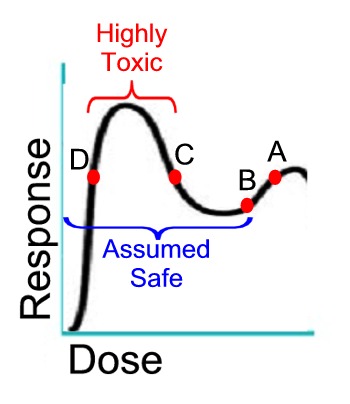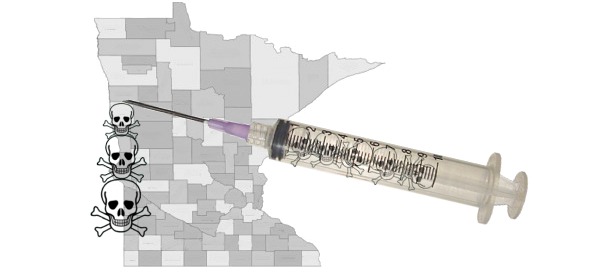Environment
Low Doses of Endocrine Disrupters Can Do More Harm Than High Doses: EPA Ignores the Truth

Photo by Screw79. PhotoStream at http://www.flickr.com/photos/39469898@N00/. (Clickable link below article.)
The rule of thumb for toxins is that the dose makes the poison. That is, the greater the dose, the more risk of harm. There is, though, one highly significant exception: endocrine disrupters.
New research confirms what has been known for decades, but widely ignored: Low doses, even very low doses, of endocrine disrupters can be as bad as high doses, and sometimes even worse.
The endocrine system produces hormones, which are messengers for other parts of the body. They’re critical for normal healthy functioning, and when unbalanced can cause a cascading effect of health damage that not only does immediate harm, but can also result in damage to future generations. Endocrine disruptors are chemicals that can mimic and interfere with normal functions.
In other words, messing with the endocrine system is playing with the health of every aspect of every animal on earth—and that includes humans. Add in the fact that low doses can be every bit as bad as high ones, then the mass dispersal of endocrine disrupting chemicals throughout the world is pure madness.
Study Documenting Low Dose Toxicity
The study, “Hormones and Endocrine-Disrupting Chemicals: Low-Dose Effects and Nonmonotonic Dose Responses”,(1) was published online this month ahead of print by the journal Endocrine Reviews. It’s an extensive review of endocrine disrupting chemical (EDC) studies, with a focus on low-dose exposures and nonmonotonic dose-response curves (NMDRCs). It sounds complicated, but the concept of NMDRCs is really fairly simple. They are curves that are neither consistently increasing nor decreasing. Refer to the following images:
 The first two curves from the left are monotonic because they go either up or down, but not both. The third and fourth curves are nonmonotonic because they do not consistently go up or down; they do both.
The first two curves from the left are monotonic because they go either up or down, but not both. The third and fourth curves are nonmonotonic because they do not consistently go up or down; they do both.
Curves reporting on the effects of endocrine disruptors tend to be more like the two on the right than those on the left. Lower doses can have greater biological effects than higher doses.
After the introduction, the authors begin their discussion with:
It is well established in the endocrine literature that natural hormones act at extremely low serum concentrations, typically in the picomolar to nanomolar range. Many studies published in the peer-reviewed literature document that EDCs can act in the nanomolar to micro-molar range, and some show activity at picomolar levels.
It’s no secret that hormones function at extremely low concentrations, even down to the smallest measurable levels. The authors report that in 2000 the Environmental Protection Agency (EPA) requested the National Toxicology Program (NTP) to evaluate the scientific evidence for:
… low-dose effects and dose-response relationships in the field of endocrine disruption. The EPA proposed that an independent and open peer review of the available evidence would allow for a sound foundation on which the EPA could “determine what aspects, if any, of its standard guidelines for reproductive and developmental toxicity testing
[would] need to be modified to detect and characterize low-dose effects”. The NTP panel verified that low-dose effects were observed for a multitude of endpoints for specific EDCs including diethylstilbestrol (DES), genistein, methoxychlor, and nonylphenol.
In other words, not only has it been known that EDCs produce harmful effects at low doses for decades, it has officially been known to the EPA. What was the EPA’s response to the report they’d ordered? Basically, they decided to ignore it, to put off the day of reckoning. Here’s a statement from their official response:
EPA believes that additional research is needed to better understand the low-dose hypothesis. An improved understanding of the mechanisms of action by which hormonally-active agents exert their effects will allow EPA to modify testing protocols as necessary to detect potential effects at low doses.(2)
Rather than accept the fact of low-dose toxicity found by their own panel, they stepped around it and talked about needing “an improved understanding of the mechanisms of action”. That is pure and utter nonsense! Knowing how endocrine disrupters do their damage is not necessary to know that they do, indeed, cause damage. So, the EPA put its collective heads in the sand and ignored their responsibility to protect the public.
Low Dose Toxicity Study Requirements
The researchers set down three standards that must be met by endocrine studies if they’re to be taken seriously as documenting an EDC concentration that can be defined as too low to be toxic. These are:
- Negative controls must be included to assure that the experimental system is free of contaminants.
- Positive controls must be included to assure that the experimental system is capable of responding to low doses of the EDC.
- Species and animal strains that are responsive to EDCs must be used in the experiment.
They then examined masses of research related to low-dose EDC exposures for specific chemical-body system combinations, and examined them for these potential flaws.
Bisphenol A (BPA) and the Prostate
The first case discussed is bisphenol A (BPA) and the prostate. They pointed out that since the initial report of low-dose BPA’s effect on the prostate, 9 studies that purportedly test the validity of that initial study have been done, and all of them claimed to be unable to duplicate it.
However, on examining those duplication studies, the authors found that they all failed at least one of the three requirements. Three of the studies even failed to include a positive control (item 2), so there was no demonstration that the study was even capable of showing low-dose toxicity. Though the rest of the studies used positive controls, each one was used inappropriately. Therefore, no studies have been done to genuinely duplicate the experiment documenting harm to the prostate from low-dose exposure to BPA.
The study continues with examinations of studies for different chemical-body system combinations. The authors clearly show that either early experiments of low-dose EDC toxicity were corroborated or follow-up experiments were too flawed to be considered valid.
Inherent Flaws in Methods of Identifying Dose Levels for Toxicity
High-dose toxicity is known and generally accepted for each of the EDCs examined. This study demonstrates either definitive low-dose toxicity or strong indications of it without adequate refutation. Therefore, the standard methods used to determine toxic doses of EDCs are completely inadequate.
Basically, a point at which concentration of the EDC is high enough to be toxic is noted. Based on that information, some calculations are made to determine a concentration to be treated as a safe dose. That is, a presumed safe zone is determined based on the assumption that only high concentrations are an issue. However, this study has documented that such an assumption is contrary to reality.
To illustrate, look at the hypothetical dose-response graph to the left. The dot A is the point at which traditional EDC testing finds a toxic dose. The calculation for a presumed safe level is point B. So, any dose below B is assumed to be safe.
However, as this study shows, it cannot be assumed that the response level will continue to be lower at doses below point B. In this example, the graph shows significantly higher toxicity level between points C and D, which are lower doses than the safe calculation at point B.
If a dose-response graph looks like this, which this study has shown is not only possible, but likely, the traditional method of determining safe and unsafe doses of EDCs doesn’t even come close to reality!
The Health Risks of Institutional Deference to Corporate Interests
This should not be a surprise to anyone involved in the study of hormones. However, toxicologists aren’t willing to accept it. That shouldn’t be surprising, since the most basic tenet of the field, that the dose makes the poison, is turned on its ear. Nonetheless, that is not an excuse for denying the evidence.
The study’s authors wrote:
At this time, it is not possible to quantify the total costs of low-dose exposures to EDCs.
However, current epidemiology studies linking low-dose EDC exposures to a myriad of health problems, diseases, and disorders suggest that the costs of current low-dose
exposures are likely to be substantial.The weight of the available evidence suggests that EDCs affect a wide range of human health endpoints that manifest at different stages of life, from neonatal and infant periods to the aging adult.
There are also intergenerational effects, as some of these chemicals, such as dioxin, are known to cause birth defects.
The authors simply call for a change in testing for the presence of EDCs. However, one must wonder how that could possibly work. Once an endocrine disrupter is in the environment, how can we control to assure that concentrations fall within an acceptable range? For that matter, how can we control exactly how much each individual is exposed to?
There is simply no reasonable option but to ban these chemicals, with the possible exceptions of necessity.
The EPA has been blithely telling us that low-dose EDCs have not been proven unsafe, though surely the inadequacies of studies trying to prove it have been obvious to them. Along with banning EDCs, we also need to ban agencies like the EPA and FDA that support the desires of multinational corporations over the health of the people, and institute agencies that truly respond to the people’s needs.
The authors of this study say that Rachel Carson, author of Silent Spring, published in 1962, was ahead of her time. She was, of course, vilified, but that’s because she was right and there was no other way to counter the implications of her research. Even today, we’re faced with the same mentality, such as the toxicologists who prefer to disavow the evidence in favor of their entrenched beliefs. As Carson said:
The control of nature is a phrase conceived in arrogance, born of the Neanderthal age of biology and philosophy, when it was supposed that nature exists for the convenience of man.
Sources:
Tagged edc, endocrine disrupter chemicals, endocrine disrupters environmental protection agency, endocrine disrupters epa, endocrine system disrupters, environment, epa endocrine disrupters, low dose endocrine disrupters















Pingback: EPA okays BPA, disses public’s right-to-know | Food Freedom News
Pingback: Activist Post: EPA okays BPA, disses public’s right-to-know | Arab Nyheter
Pingback: EPA Okays BPA, Rejects Public’s Right-To-Know
Pingback: BPA Harms At Much Lower Levels Than Previously Thought – Waking Times
Pingback: Banoosh » » BPA Harms At Much Lower Levels Than Previously Thought
Pingback: BPA Harms At Much Lower Levels Than Previously Thought | lyranara.me